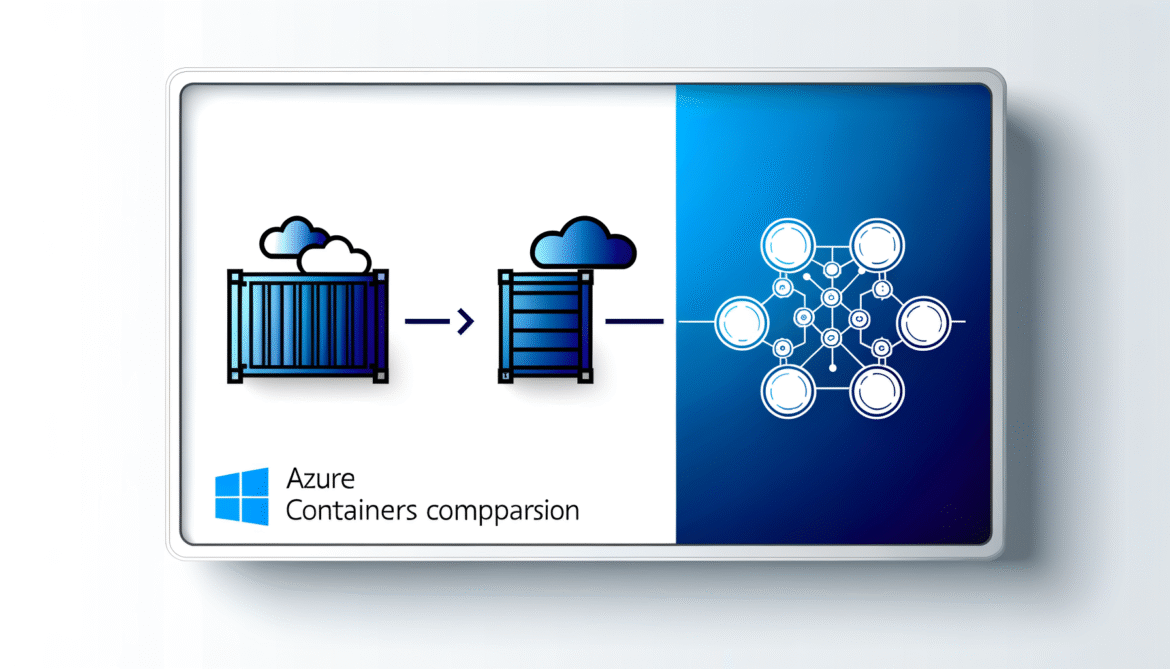- Azure Container Services Comparison: Container Apps vs Container Instances vs AKS – Part 1: Overview and Core Differences
- Azure Container Services Comparison – Part 2: Deep Dive Implementation & Code Examples
- Azure Container Services Comparison – Part 3: Scaling, Networking & Advanced Features
- Azure Container Services Comparison – Part 4: Cost Analysis & Migration Strategies
- Azure Container Services Comparison – Part 5: Production Considerations & Future Roadmap
Azure Container Services Comparison: Container Apps vs Container Instances vs AKS
Part 1: Overview and Core Differences
As Azure continues to expand its container offerings, developers often find themselves choosing between three primary services: Azure Container Instances (ACI), Azure Container Apps (ACA), and Azure Kubernetes Service (AKS). Each serves different needs in the containerization spectrum, and understanding their core differences is crucial for making the right architectural decisions.
The Container Service Spectrum
Think of Azure’s container services as a spectrum of complexity and control:
Azure Container Instances (ACI) → Azure Container Apps (ACA) → Azure Kubernetes Service (AKS)
Simple & Fast ←→ Balanced ←→ Complex & Powerful
Azure Container Instances (ACI): The Simplest Entry Point
ACI is Azure’s serverless container offering, designed for scenarios where you need to run a container quickly without infrastructure management.
Key Characteristics:
- Serverless: No VM management required
- Per-second billing: Pay only for what you use
- Quick startup: Containers typically start in seconds
- Simplicity: Minimal configuration needed
Best Use Cases:
- Batch processing jobs
- Build agents for CI/CD pipelines
- Task automation and scheduled jobs
- Development and testing environments
- Simple web applications with predictable traffic
Limitations:
- No built-in load balancing
- Limited networking options
- No auto-scaling capabilities
- Single container or simple container groups only
Azure Container Apps (ACA): The Balanced Middle Ground
Container Apps represents Microsoft’s newest addition to the container ecosystem, built on top of Kubernetes but abstracting away its complexity.
Key Characteristics:
- Microservices-focused: Built for distributed applications
- Event-driven scaling: Auto-scale based on HTTP, queues, or custom metrics
- Integrated ingress: Built-in load balancing and SSL termination
- Dapr integration: Native support for distributed application patterns
Best Use Cases:
- Microservices architectures
- API backends and web applications
- Event-driven workloads
- Applications requiring auto-scaling
- Services that need service-to-service communication
Sweet Spot: Container Apps shines when you need more than ACI’s simplicity but don’t want AKS’s complexity. It’s particularly powerful for modern, cloud-native applications.
Azure Kubernetes Service (AKS): Maximum Control and Flexibility
AKS provides a fully managed Kubernetes experience, offering the complete power of the Kubernetes ecosystem.
Key Characteristics:
- Full Kubernetes API: Complete control over cluster configuration
- Extensive ecosystem: Access to the entire CNCF landscape
- Advanced networking: Support for complex network topologies
- Enterprise features: RBAC, network policies, private clusters
Best Use Cases:
- Complex, multi-tier applications
- Legacy application modernization
- Workloads requiring specific Kubernetes features
- Organizations with Kubernetes expertise
- Applications with complex networking requirements
- Multi-cloud or hybrid deployments
Considerations:
- Requires Kubernetes knowledge
- More complex to set up and maintain
- Higher operational overhead
- Greater flexibility comes with greater responsibility
Quick Decision Matrix
| Criteria | ACI | Container Apps | AKS |
|---|---|---|---|
| Complexity | Low | Medium | High |
| Setup Time | Minutes | Minutes | Hours |
| Kubernetes Knowledge | None | None | Required |
| Auto-scaling | No | Yes | Yes (with configuration) |
| Load Balancing | External | Built-in | Configurable |
| Cost Model | Per-second | Per-vCore-second | Node-based |
| Use Case Complexity | Simple | Medium | Complex |
What’s Coming Next
In Part 2, we’ll dive deep into practical implementation examples with real code, showing you exactly how to deploy applications on each service.
In Part 3, we’ll explore scaling strategies, networking options, and advanced features that differentiate these services in production environments.
In Part 4, we’ll analyze costs and migration strategies to help you make informed decisions about moving between services.
In Part 5, we’ll cover production considerations, monitoring, and Microsoft’s future roadmap for container services.
Ready to make the right choice for your next containerized application? The key is understanding not just what each service can do, but when each service should be your go-to solution.







